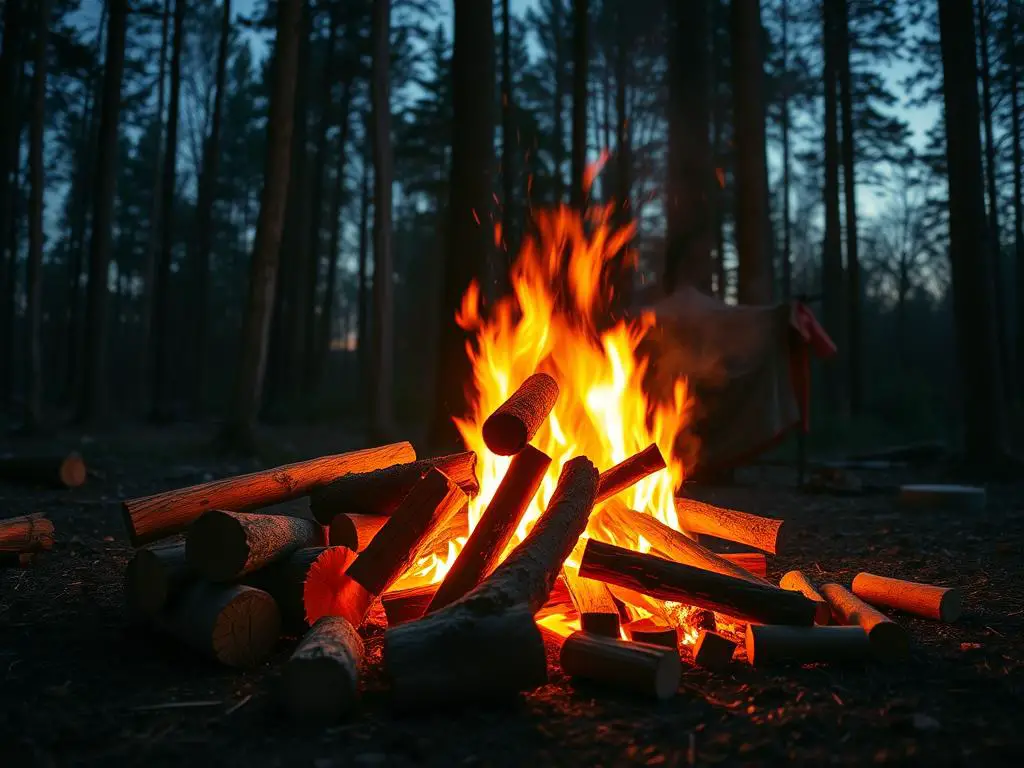Did you know 80% of campers struggle to start their campfires because of the wrong wood? The right wood can turn a frustrating experience into a roaring success. It’s essential for warmth, cooking, and making memories under the stars.
Whether you’re an experienced camper or new to it, knowing the right wood can improve your campfire. Let’s look at the top picks for your next outdoor trip. We’ll cover everything from the best campfire wood bundle to the perfect fire starter kindling.
Key Takeaways
- Hardwoods like oak and maple provide long-lasting heat for campfires
- Fruitwoods offer pleasant aromas and enhance food flavors
- Proper wood seasoning is crucial for efficient burning
- Avoid treated woods and softwoods for safer, less smoky fires
- Choose smaller logs for easier ignition and efficient burning
Introduction to Campfire Woods
Choosing the right wood for your campfire is crucial. It can make or break your outdoor adventure. Seasoned firewood is essential for a great campfire. It burns more efficiently and produces less smoke than fresh wood.
When picking wood for your campfire, consider these factors:
- Heat output
- Burn time
- Smoke production
- Availability
Dry hardwood logs are the best choice for campfires. They burn longer and hotter than softwoods. This makes them perfect for cooking and staying warm. Oak, maple, and ash are top hardwoods for burning well.
“The right wood can turn a good campfire into a great one.”
Woods like cherry and apple give off pleasant aromas. They’re great for cooking and add a nice flavor to your food. The best campfire wood is seasoned for at least six months. This ensures it burns well and produces more heat with less smoke.
Best Wood for a Campfire: Top 5 Choices
Choosing the right wood for a campfire is key to a great outdoor experience. The best wood burns longer, hotter, and cleaner. This makes your camping trip more enjoyable. Let’s look at the top five picks for smoke-free firewood to keep you warm and cozy.
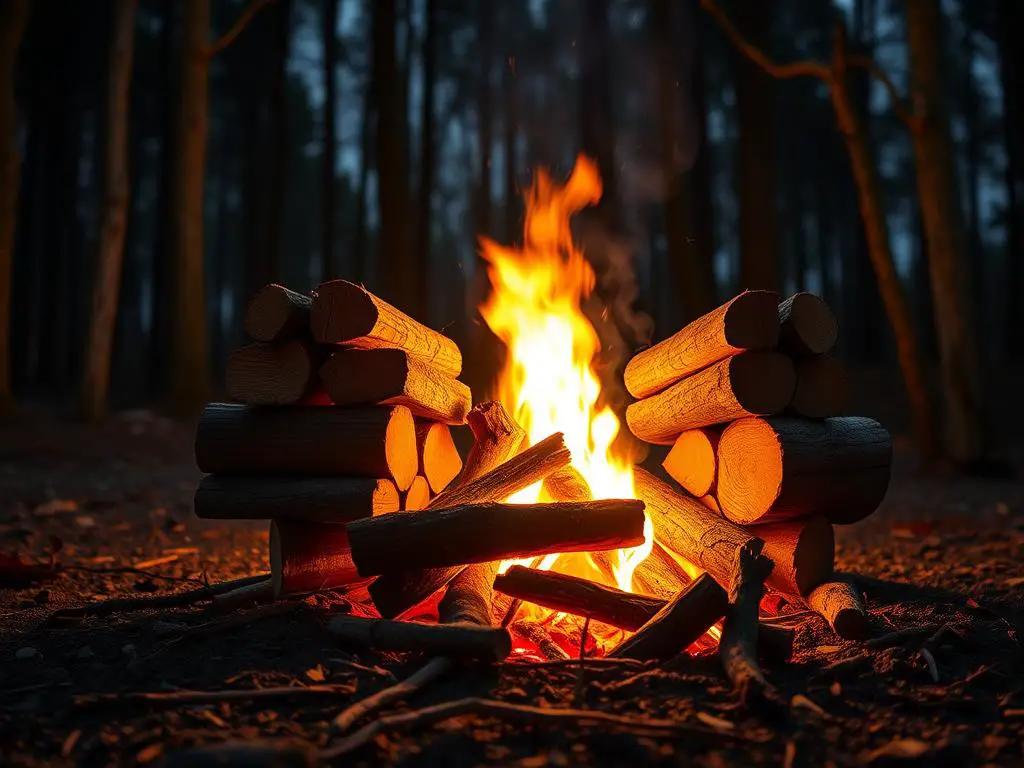
Oak is the top choice for campfires. It’s found all over the U.S. and burns slowly and steadily. Oak gives off a lot of heat and very little smoke, making it perfect for camping.
Cherry and apple woods are loved for their smell. These fruit woods are common and great for cooking. They burn moderately and add a nice scent to your campsite.
Beech is a heat powerhouse. It’s mainly found in the east and burns slowly. This makes it ideal for colder camping trips.
Maple is found in the northeast and is versatile. It burns moderately and cleanly. This makes it a reliable choice for different camping needs.
Ash completes our top five. It’s easy to use and found in the east. Ash lights fast, produces little smoke, and gives off a lot of heat.
“The right firewood can transform a good camping trip into an unforgettable experience.”
Remember, wood with less than 20% moisture burns cleaner and better. Choose kiln-dried wood for the best campfire experience.
Oak: The All-Around Champion
Oak is a top pick for campfires. It’s easy to find in the United States. Oak fires burn hot and long, with little smoke or sparks.
There are two types of oak for campfires: red and white. Both burn well, but white oak lasts a bit longer. Oak fires also give off a nice, nutty smell.
Oak is great for many campfire activities:
- Cooking: Oak’s steady heat is perfect for grilling and roasting.
- Warmth: It keeps campers warm on cold nights.
- Ambiance: Oak fires spark less, making them safer and more enjoyable.
Make sure to choose seasoned oak for your campfire. Dried oak lights up quickly and burns well. Oak’s availability, heat, and low smoke make it the best campfire wood.
“Oak is the backbone of a great campfire. It’s reliable, burns hot, and lasts long – everything you want for a perfect outdoor experience.”
Cherry and Apple: Aromatic Fruit Woods
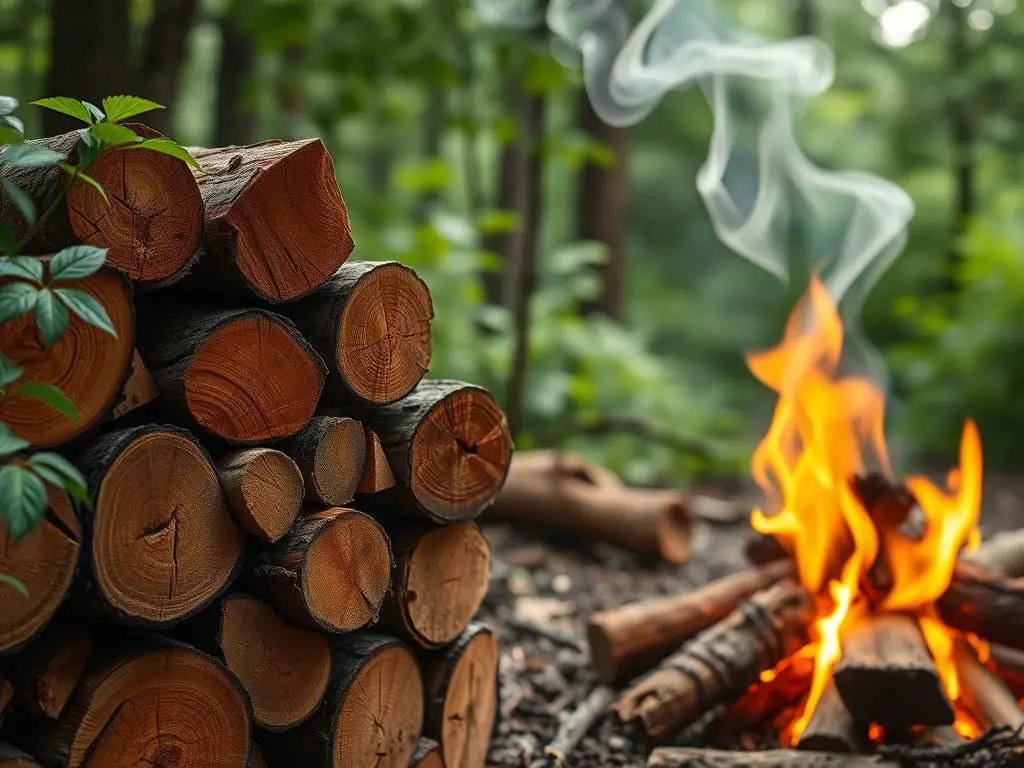
Cherry and apple woods are top picks for campfires. They offer a mix of nice smells and good burning. Campers enjoy them for their little smoke and low sap, making fires cozy.
Cherry wood adds a mild, fruity smoke to your fire. It’s great for smoking meats like beef, pork, and poultry. It also makes food look beautiful with its reddish color. Cherry burns slowly and heats well, keeping your fire steady.
Apple wood is loved for its sweet smell and ease of use. It’s perfect for smoking chicken, turkey, and pork, especially ham. It’s easy for beginners and seasoned campers alike. When seasoned right, it burns well and adds a sweet scent to the air.
“Cherry and apple woods offer a perfect balance of aroma and heat, creating an inviting atmosphere around any campfire.”
Cherry and apple woods make campfires special. They add to the ambiance and are great for outdoor cooking. Whether you’re making s’mores or a big meal, these woods will make your camping trip better.
Beech: Slow-Burning Heat Source
Beech is a top pick for campfires that last long. Found mainly in eastern states, it’s as good as oak. It burns hot and slow, giving off useful coals for long camping trips.
Beech is second only to ash for fireplaces. It burns well because of its density. Seasoned beech burns hot and steady, keeping campers warm at night.
Beech might not smell as nice as fruit woods, but many enjoy its scent. However, beech can spit embers, so be careful when roasting marshmallows.
Beech is a high-grade firewood with excellent burning characteristics, rivaling oak in performance.
Splitting beech is hard because of its density. But, its long heat and slow burn make it a great oak substitute. For campers looking for reliable firewood, beech is a great choice.
- Provides hot, slow burn
- Produces useful coals
- Requires proper seasoning
- Offers long-lasting heat
Maple: Versatile and Moderate Heat
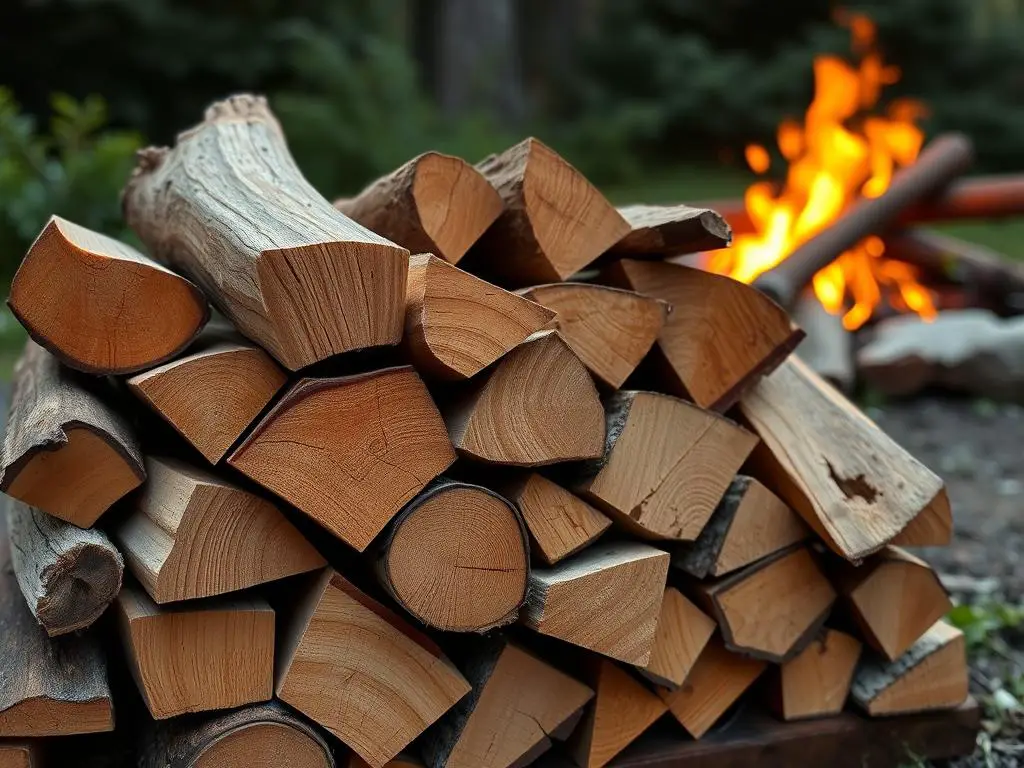
Maple is a great choice for your campfire wood bundle. It burns clean and produces less creosote, making it eco-friendly. Found in northeastern states and eastern Canada, it gives off moderate heat, perfect for different camping needs.
Maple isn’t the hottest wood, but it beats many others. Its BTU rating is between 18 to 25 million per cord, depending on the type. Sugar maple, for example, burns hotter than softer types. Its sweet smell makes your campfire even more enjoyable.
Campers love maple for its easy splitting and good coaling. It burns with little smoke, making your fire pit area cozy. Plus, it produces fewer sparks, keeping your campsite safe for everyone.
Maple wood is a camper’s delight – easy to light, clean-burning, and aromatic.
When picking your campfire wood, mix maple with oak or beech for more heat. Make sure it’s seasoned well for better burning and less smoke. Maple’s moderate heat, nice smell, and green qualities make it a top pick for camping.
Read More-
Ash: The Easy-to-Use Firewood
Ash wood is a top pick for those who love campfires and want smoke-free wood. It burns clean and efficiently, making fires enjoyable. Found in the eastern United States, ash wood heats well without much smoke or sparks.
Campers find ash easy to use. It lights fast and burns steadily, great for cooking and warmth. It’s perfect for outdoor fun, like roasting marshmallows or cooking meals over the fire.
One camper said: “I used ash for my last camping trip, and it was a game-changer. The fire burned clean and hot, with minimal smoke. It made our evening around the campfire so much more enjoyable.”
“Ash wood behaves similarly to oak in woodworking, being strong and hard. It’s a versatile choice for both structural and decorative projects.”
Woodworkers will find ash exciting. Trek Pelican’s guide on outdoor activities shows ash’s uses in woodworking. Season ash wood for two years before use to avoid problems like twisting or cracking.
- Lights easily and burns efficiently
- Produces minimal smoke and sparks
- Suitable for cooking and warmth
- Versatile for woodworking projects
Planning a camping trip or a backyard bonfire? Choose ash as your smoke-free firewood. Its ease of use and clean burning make it a favorite among outdoor lovers.
Understanding Wood Seasoning for Campfires
Wood seasoning is key for a great campfire. Seasoned wood burns better, makes less smoke, and lights up easily. It’s dried for six months to a year, cutting its moisture to 20% or less.
Dry hardwood logs are best for campfires. Oak burns slowly, giving lots of heat and clean burns. Maple burns hot, makes little smoke, and smells nice, perfect for cooking.
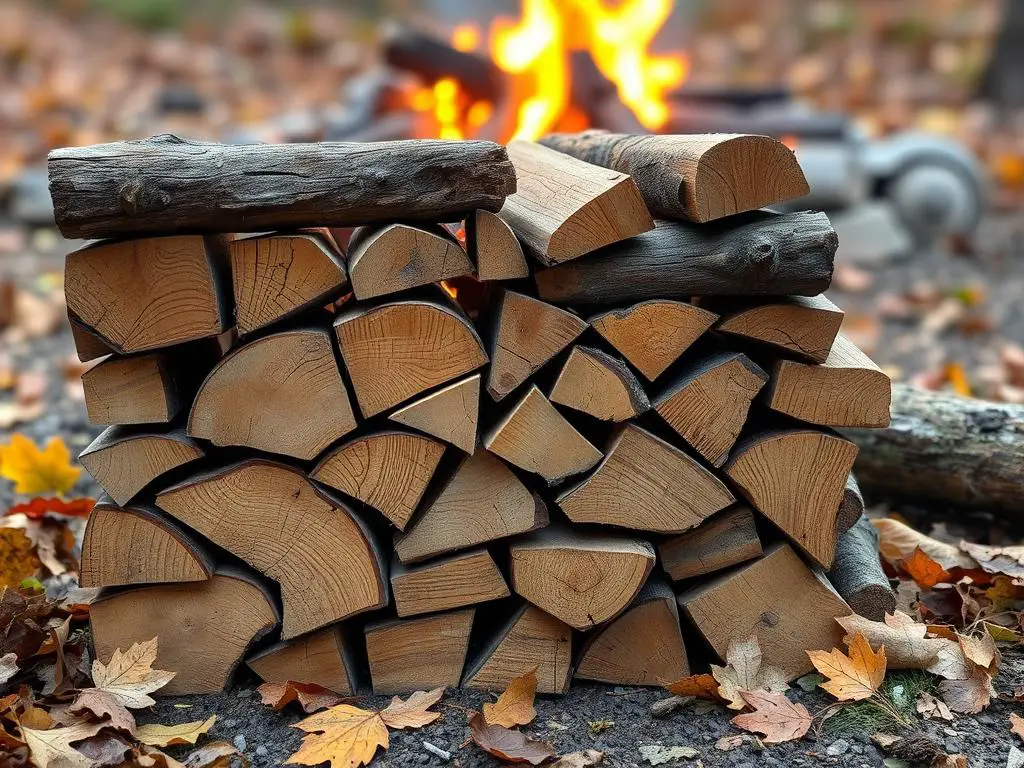
- Hardwoods burn longer and produce more heat than softwoods
- Hardwoods are denser, making them ideal for winter camping
- Softwoods ignite faster but burn quickly
- A combination of softwood and hardwood offers quick ignition and long-lasting heat
Green wood with high moisture burns poorly and makes lots of smoke. Always choose seasoned firewood for the best campfire. Don’t burn treated or painted wood, as it can release harmful substances.
“The key to a perfect campfire lies in the quality of your seasoned firewood.”
Hardwoods vs. Softwoods: What’s Best for Your Campfire?
Choosing the right wood for your campfire is key. Hardwoods like oak, hickory, and ash are better than softwoods like pine and cedar. They burn longer and hotter, making them perfect for campfires.
Hardwoods are top-notch for campfires. They burn for a long time, give off more heat, and produce less smoke. Oak is great because it burns slowly and gives off a lot of heat. Hickory is even hotter, making it perfect for cooking.
Softwoods have their own benefits. They’re lighter and easier to start a fire with. Pine lights up fast and burns brightly, but it doesn’t last long. Cedar gives off a nice smell and burns moderately, good for short campfires.
“Seasoned wood is key for the best campfire experience,” says expert camper Emma Thompson. “Look for wood with less than 20% moisture content for easy ignition and clean burning.”
When picking wood for your campfire, consider these points:
- Burn time: Hardwoods last longer
- Heat output: Hardwoods give more heat
- Smoke production: Hardwoods make less smoke
- Ease of ignition: Softwoods are easier to light
- Aroma: Some woods like cedar smell nice
The choice depends on what you need. For a long, hot campfire, go with hardwoods. For a quick start or a short fire, softwoods are better. Always use seasoned wood for the best results.
Campfire Wood Safety and Environmental Considerations
Choosing the right wood for your campfire is key for safety and protecting the environment. Campfire wood accessories are important for enjoying the outdoors responsibly. Hardwoods like oak, hickory, or maple are best. They burn longer, hotter, and cleaner than softwoods.
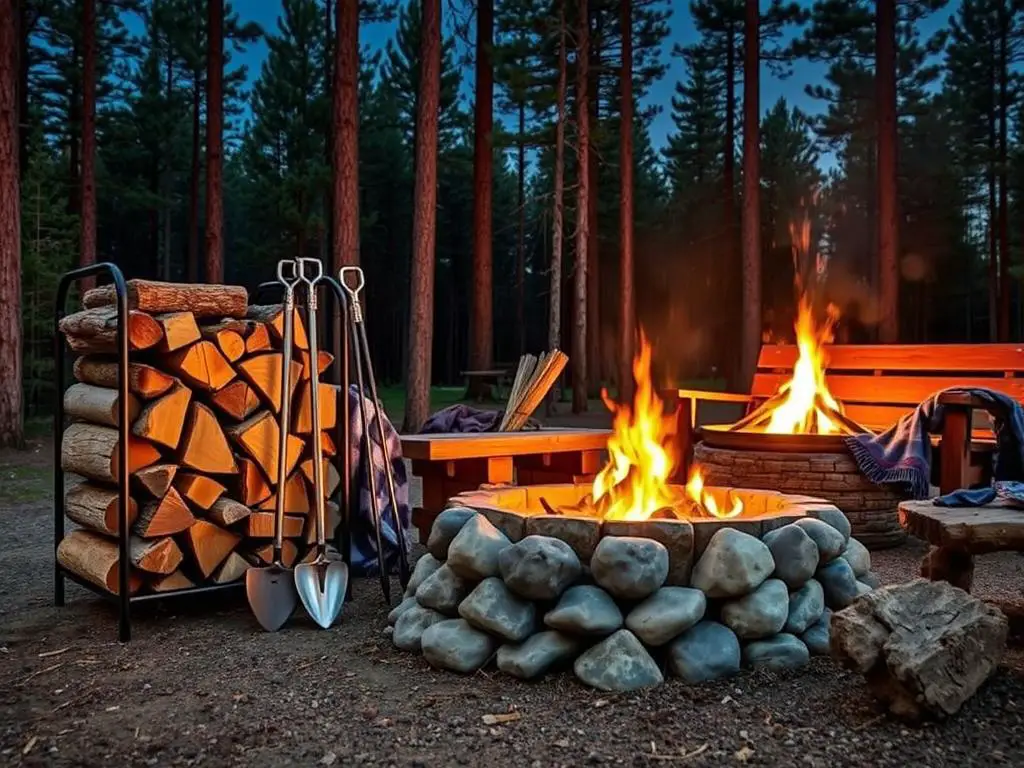
Safety is crucial when making campfires. Use wood that’s been dried for at least six months. This means it burns better and produces less smoke. Stay away from wood that’s been treated, painted, or pressure-treated. It can release harmful chemicals when burned.
It’s also important to think about the environment. The growing demand for firewood is harming many natural areas. To help:
- Use dead and down wood that burns quickly and is easy to collect
- Choose small pieces of wood, no larger than an adult’s wrist
- Avoid burning wood from endangered or protected species
- Opt for sustainably sourced firewood from common, fast-growing trees
Using campfire wood accessories responsibly helps keep our natural spaces safe for the future. By following these tips, you can have a safe and eco-friendly campfire.
How to Properly Store and Prepare Campfire Wood
Storing dry hardwood logs right is key for a great campfire. Keep your wood outside, stacked neatly with the top exposed to air. This helps it dry well. Make sure to place the logs at least 20 feet from your house to avoid pests.
Put your woodpile on a raised platform to improve airflow. This stops moisture from getting in. Many log stores have open fronts to let in more air. This keeps the wood dry, below 20% moisture, for clean burning.
When you’re ready for your campfire, collect three types of wood:
- Ramp wood: Green sticks about 3 feet long and 2 inches in diameter
- Fire starter kindling: Small, dry pieces for easy ignition
- Fuel wood: Dry logs roughly 2 feet long and 4-6 inches in diameter
Split big logs into smaller pieces for easier lighting and better burning. Place your fire starter kindling and smaller wood at the fire pit’s base. This helps start the fire quickly and keeps it burning steadily.
“Dry firewood burns quicker and is easier to light, making your campfire experience more enjoyable and hassle-free.”
By following these tips, you’ll have everything you need for a cozy campfire. Well-prepared wood is the secret to warmth and fun for hours.
Alternative Woods for Unique Campfire Experiences
Campfire lovers enjoy the sound of a crackling fire. But have you tried different woods? Let’s explore some alternatives to make your outdoor adventures more exciting.
Cedar is known for its aromatic scent, making camping more enjoyable. However, it can spark more than other woods, so be careful.
Birch is great for quick fires. It burns hot and fast, perfect for cold nights. Plus, its papery bark is a great fire starter.
- Willow: Offers a bright flame and good heat
- Tamarack: Known for its intense heat
- Alder: Easy to gather, burns quickly
Fruit woods like apple, cherry, peach, or pear add flavor to your campfire cooking. They make your outdoor meals more aromatic.
“Different woods burn at different temperatures, creating unique campfire experiences.”
Hardwoods like oak, maple, and beech burn longer and hotter. Softwoods like pine burn faster but produce more smoke.
Trying different woods can make your campfire adventures better. Just remember to follow local firewood rules to protect the environment and prevent pest spread.
Campfire Cooking: Choosing the Right Wood for Culinary Delights
Choosing the right wood for campfire cooking is key to a great outdoor meal. Hardwoods like oak, maple, and hickory are great. They burn slowly and give consistent heat, perfect for grilling and roasting.
Aromatic wood for campfires like apple and cherry add unique flavors. Oak gives a strong smoky taste, while maple is milder and sweeter. Seasoned wood, dried for at least six months, burns cleaner and hotter.
Don’t use softwoods like pine or cedar for cooking. They can make food taste bad and even be harmful. Stick to hardwoods for better flavor and cooking results. The right wood makes campfire cooking a gourmet experience, turning meals into adventures.
FAQ
What are the most important factors to consider when choosing wood for a campfire?
Important factors include heat output, burn time, smoke production, and availability. Different woods have different qualities. Think about what you need, like cooking or warmth.
What are the top five woods recommended for campfires?
Top woods are oak, cherry, apple, beech, and ash. These hardwoods burn long, hot, and with little smoke.
Why is seasoned firewood better for campfires?
Seasoned wood burns better and produces less smoke. It dries out over 6-12 months. This makes it easier to light and burns hotter.
Should I use hardwoods or softwoods for my campfire?
Hardwoods like oak, maple, and ash are best. They burn longer, hotter, and with less smoke. Softwoods are good for starting fires or quick flames.
What safety and environmental considerations should I keep in mind when selecting and using campfire wood?
Don’t burn treated or painted wood, as it can release toxic fumes. Know local firewood transport rules to stop invasive species spread. Always follow fire safety, including building and extinguishing fires correctly.
How should I store and prepare campfire wood for optimal performance?
Keep wood dry and in a well-ventilated area. Split logs for easier ignition and burning. Use kindling and small wood to start the fire fast.
Are there any alternative woods that can provide unique campfire experiences?
Yes, woods like cedar, birch, and fruit woods like peach or pear offer unique smells and tastes. Trying different woods can make your campfire better.
Which woods are best for cooking over a campfire?
Fruit woods like apple and cherry are great for smoking and adding flavors. Oak is good for grilling with a strong flavor. Maple is mild and sweet. Avoid softwoods or resinous woods, as they can harm your food.
